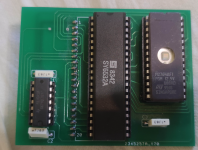SiriusHardware
Veteran Member
If you are able to read the original PROM you can check the code you read out from it against the corresponding file on Zimmers. That way, you can find out whether the original PROM is OK or not.
If it is OK, then you don't need to spend time and money to create a replacement.
If you don't have a PROM reader but you do have a working PET then you might be able to put the PROM into a spare socket in the PET and use the built in machine code monitor - I think there is one? - to view the hex code in the PROM and compare it with the corresponding code file on Zimmers. This would depend on the FDD's PROM being pin compatible with the PET PROMs.
If it is OK, then you don't need to spend time and money to create a replacement.
If you don't have a PROM reader but you do have a working PET then you might be able to put the PROM into a spare socket in the PET and use the built in machine code monitor - I think there is one? - to view the hex code in the PROM and compare it with the corresponding code file on Zimmers. This would depend on the FDD's PROM being pin compatible with the PET PROMs.
Last edited:

